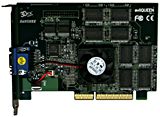
PowerColor Evil Queen Voodoo Banshee video card
Review date: 16 April 1999. Last modified 03-Dec-2011.
Time and technology march on, and they do it darned quickly in the computer world. Today's steaming hot video card is tomorrow's free-to-a-good-home wouldn't-be-seen-dead-with-it crawler. This is something of a bummer if you've got a fetish to keep up with the bleeding edge of technology, but it's a boon to those who are happy to buy gear a generation or two old.
The Voodoo Banshee wasn't really 3Dfx's flagship product even when it was brand new. In brief, it's a good value 2D/3D video chipset, with unnecessarily fast 2D (every video card on the shelf these days has better 2D performance than practically anybody needs) and quite capable 3D. It's not as fast as the older 3D-only Voodoo 2 chipset, but it's capable of higher resolution output in 3D - a single Voodoo 2 board can't manage resolutions higher than 800 by 600 except in those few games that don't use Z-buffering. In games that don't use multitexturing, a Voodoo Banshee is almost exactly as fast at a given resolution as a Voodoo 2, but can handle higher resolutions as well. In games like Quake 2 and Unreal, though, the Voodoo 2's multitexturing ability makes it a considerably better performer, and to maintain a decent frame rate the Banshee has to be run at a lower resolution.
PowerColor's somewhat risibly named Evil Queen is their entry in the Banshee board race. All Banshee boards are very much the same; the ones with better chip cooling can stand to run a little faster, but the performance differences are trivial and price is the first consideration. For more information on how the Banshee cuts it in comparison with its peers, the Voodoo 2 and Riva TNT, check out my full review of Diamond's Banshee-powered Monster Fusion board here. The Monster Fusion is the generally agreed top of the Banshee heap, so I was interested to see how its Taiwanese competition stacked up.
The Evil Queen's chief feature is its price. It currently retails for $199 (Australian dollars), and you can expect to find it for less as Voodoo 3 boards start to become locally available. The Monster Fusion, with identical performance, still lists for $340, although this too will drop in the near future.
So what's the difference?
Compare and contrast
Like the Monster Fusion, the Evil Queen is available in AGP and PCI versions, and again like the Monster Fusion the AGP version is slightly faster, because it's got slightly faster RAM (all Banshee boards have 16 megabytes of RAM, but some use slower SDRAM, some faster SGRAM) and is clocked slightly higher. The difference between the versions is marginal at best. I checked out the AGP incarnation.
Both the Monster Fusion and the Evil Queen have a heatsink with a fan mounted on top of the toasty-warm Banshee chip; many of the cheaper Banshee boards make do with a bare heatsink, or even no chip cooler at all. The Queen's chip cooler doesn't look as sexy as the Diamond board's unit, and it may or may not work as well, but since the biggest performance improvement you can screw out of a Banshee board by overclocking it is 10%, and that only if you're very lucky, there's not a lot of point carping about the efficiency of the cooling system unless you live in the Gobi Desert. The Evil Queen's got a fan. It goes round and round. Good enough.
The Evil Queen comes with a software CD and an English/Chinese manual, the English in which is rather better than the usual entertainingly incomprehensible Taiwanese documentation. Apart from the drivers, which are a lightly facelifted version of the 3Dfx reference Banshee drivers and perfectly acceptable, the CD also contains a couple of card-tweaking utilities of no particular merit and the usual smattering of game demos - in this case Pod, Tomb Raider 2 and Sabre Ace. The Monster Fusion has a better game bundle - a hefty Unreal demo and all of Motocross Madness - but it's still nothing to get too excited about, much less pay an extra $140 for.
The CD also seems to have drivers on it for pretty much every other graphics card PowerColor make, but the manual and a document file on the CD make it easy to set up the Evil Queen without being confused by any other drivers.
Conclusion
There's not much not to like in the Evil Queen. Except, perhaps, its silly name. It's a well made board with the same specifications as the more expensive Monster Fusion, its manual will not require you to engage the services of a professional translator, and it doesn't pump up its price with three old games you don't want. If you're looking for quality in a mid-priced 2D/3D video card, the Evil Queen looks like a great choice. Unlike cheaper options (like, for example, Jaton's Riva 128ZX-based Video-78AGP, reviewed here), the Evil Queen supports the Glide Application Programming Interface, which makes sure it'll be compatible with pretty much every 3D game, regardless of age.
If you automatically dismiss off-brand hardware as being dodgily made and poorly supported, make an exception for this board. It's worth a look.


![[SecureWebs]](images/sw.gif)